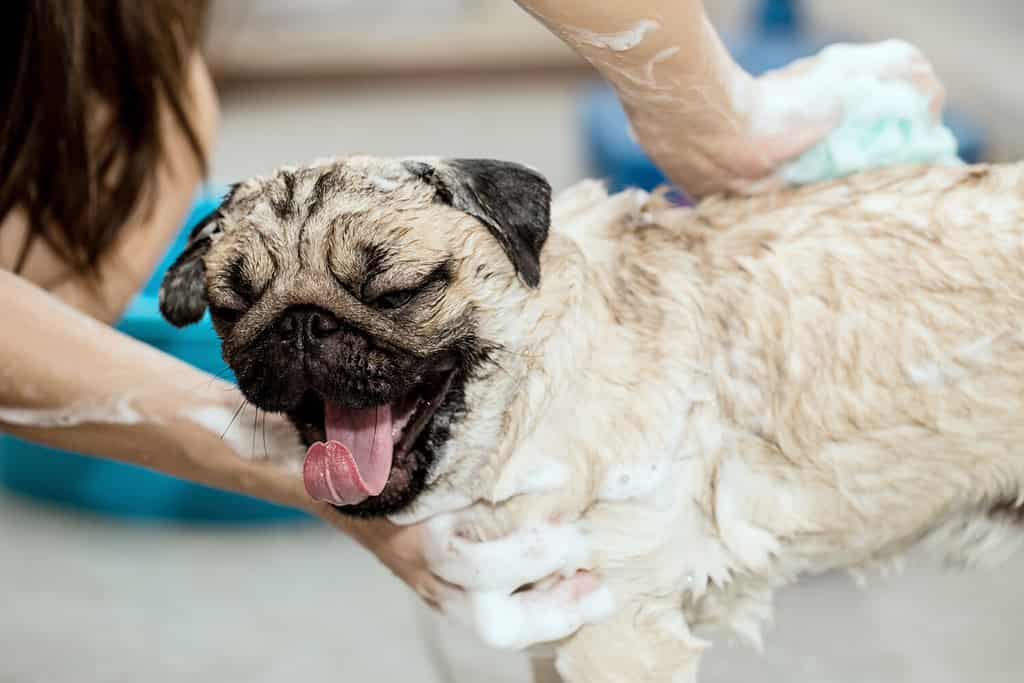Pugs are becoming increasingly popular. They’re known for their friendly nature and adorable looks. However, they are also prone to several health problems. (In fact, they’re one of the least healthy dog breeds out there.)
Still, if you have allergies, you may be wondering if pugs are a suitable option for you.
Sadly, no, pugs are not hypoallergenic. They can produce allergens that trigger allergic reactions in those sensitive to them. Therefore, they aren’t a great option for most people with allergies.
However, that doesn’t mean all is lost. Keep reading for information on what hypoallergenic really means and for information on how you may be able to live with a Pug – even if you have allergies.

Sadly, no, pugs are not hypoallergenic.
©Alex_Zh/Shutterstock.com
What are Allergens and Hypoallergenic Dogs?
Allergens are substances that can trigger allergies. Usually, they are proteins. While allergens aren’t actually dangerous, someone with allergies has an immune system that thinks they are. Therefore, their immune system will react to the allergens.
This reaction is what causes all the symptoms associated with allergens, including sneezing, running nose, itchy eyes, and hives. Those with dog allergies are allergic to the proteins dogs make, which are present in their saliva, skin, and urine.
All dogs create these proteins, so all dogs can cause allergens. It’s a common misconception that dog hair causes an allergic reaction, but this isn’t true. The hypoallergenic dog is largely a myth.
Studies have found that even dogs commonly marketed as “hypoallergenic” don’t produce fewer allergens than other dog breeds.

An allergist can help you determine exactly what you are allergic to and develop a treatment plan specifically tailored to your needs.
©Microgen/Shutterstock.com
Not Everyone is Allergic to All Proteins
When someone experiences allergy symptoms, they typically get an allergy test done by their doctor. When this happens, the allergen that represents “dogs” has all the proteins dogs create. Therefore, if you have a reaction to that spot on the test, you’re typically said to be allergic to dogs.
However, that isn’t exactly true. Most people aren’t allergic to all proteins dogs make – just one or two. During a broad allergen test, it often makes sense to test for “dogs” in general. You can ask for a more specific test that checks each protein separately, though.
The good news is that not all dogs make the same proteins. Therefore, you may be allergic to some Pugs and not others. For instance, only male dogs produce Can F 5. If you’re only allergic to this protein, you could own female dogs without symptoms.
Some dogs may produce more of one protein than another, though we may not know exactly why. Therefore, the only way to know if you’re allergic to a specific dog is to spend time around that dog.
Reducing Allergy Symptoms
Even if you are allergic to Pugs, there are many ways you can reduce allergy symptoms. In some cases, you may be able to live just fine with a Pug if you take some appropriate steps.
Of course, this works best for those with minor allergy symptoms. Your symptoms may get worse or better as you spend time around dogs. Some people find that they get “used to” the allergens, while others find that long-term exposure makes their symptoms worse.

Some people find that they get “used to” the allergens, while others find that long-term exposure makes their symptoms worse.
©220 Selfmade studio/Shutterstock.com
Here are some ways you can reduce your allergy symptoms:
Reduce Your Allergen Load
Think of your allergies like one big bucket. This bucket slowly fills up with allergens as you go about your daily life. Anything you’re allergic to fills up this bucket, including pollen and seasonal allergies.
Once this bucket reaches a certain level of fullness, you’ll start experiencing symptoms.
You can reduce your allergic reaction to your canine by reducing how full your bucket is overall. You may only react to your dog in the spring when you’re also being bombarded by other allergens, for instance. If you can reduce your exposure to these other allergens, your bucket may never get full enough for symptoms from your dog alone.
This also works between different dogs. For instance, if someone is very allergic to male dogs and not very allergic to females, they may get along just fine with a female dog. However, if they spend time with a male dog, they may start reacting to their female dog suddenly – because their bucket is full.
There are several stories online regarding someone adopting a new dog and then suddenly becoming allergic to all of their dogs. In all likelihood, the new dog probably made more of an allergen that upset their immune system, causing them to suddenly be more sensitive to all allergens.
Keep Everything Clean
Allergens can stick to all sorts of surfaces. Therefore, the best way to reduce your exposure to the allergens your pug makes is to keep everything clean. If you have carpets, you’ll want to vacuum more. You may even try to reduce the number of allergen-holding surfaces in your home, such as removing curtains.
You should keep surfaces wiped down and wash blankets regularly. Living with a dog when you have an allergy often just boils down to keeping everything very clean.
You should use a HEPA filter to keep your air clean, too. In many cases, you can drastically reduce your allergy symptoms by using a high-quality air filter (though these can be expensive).
Bathe Your Dog Regularly
You can also reduce the number of allergens on your dog by keeping them bathed. However, there is a fine line to walk here.
Baths do reduce the number of allergens on your dog, which will reduce your symptoms. However, many dogs are sensitive to continuous bathing, especially pugs. Too much bathing can dry out your dog’s skin and make them produce more allergens, which is the opposite of what you want.
Therefore, you should use a gentle shampoo and only bathe your dog as much as you can without irritating their skin. Sadly, pugs are prone to skin problems, which may make them produce more allergens overall. Therefore, they may not be the best dog for those with allergies.
However, you can purchase a healthier pug from a quality breeder, which may reduce their skin problems and make them easier for you to be around.
Establish “Dog-Free” Zones
You should establish “dog-free” zones around your home, particularly in your bedroom. You sleep for a considerable amount of time in your bedroom each night. If you can keep allergens out of this room, you’ll considerably reduce the allergens you’re exposed to. This helps keep your allergen bucket from getting full, which reduces symptoms.
Keep your dog out of your bedroom and keep a HEPA filter next to your bed to reduce the allergens circulating.
You should also establish dog-free zones on your furniture, as these can hold massive amounts of allergens.
Medication
You can also take medication to reduce your allergy symptoms. You should speak with your doctor about which medications may be right for you. If you are currently prescribed medications, be sure to take them as directed.
Ready to discover the top 10 cutest dog breeds in the entire world?
How about the fastest dogs, the largest dogs and those that are -- quite frankly -- just the kindest dogs on the planet? Each day, AZ Animals sends out lists just like this to our thousands of email subscribers. And the best part? It's FREE. Join today by entering your email below.
Thank you for reading! Have some feedback for us? Contact the AZ Animals editorial team.








